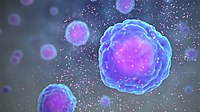
Photo from wikipedia
AIMS Inflammation is a key factor in atherosclerosis. The transcription factor interferon regulatory factor-5 (IRF5) drives macrophages towards a pro-inflammatory state. We investigated the role of IRF5 in human atherosclerosis… Click to show full abstract
AIMS Inflammation is a key factor in atherosclerosis. The transcription factor interferon regulatory factor-5 (IRF5) drives macrophages towards a pro-inflammatory state. We investigated the role of IRF5 in human atherosclerosis and plaque stability. METHODS AND RESULTS Bulk RNA sequencing from the Carotid Plaque Imaging Project biobank were used to mine associations between major macrophage associated genes and transcription factors and human symptomatic carotid disease. Immunohistochemistry, proximity extension assays, and Helios cytometry by time of flight (CyTOF) were used for validation. The effect of IRF5 deficiency on carotid plaque phenotype and rupture in ApoE-/- mice was studied in an inducible model of plaque rupture. Interferon regulatory factor-5 and ITGAX/CD11c were identified as the macrophage associated genes with the strongest associations with symptomatic carotid disease. Expression of IRF5 and ITGAX/CD11c correlated with the vulnerability index, pro-inflammatory plaque cytokine levels, necrotic core area, and with each other. Macrophages were the predominant CD11c-expressing immune cells in the plaque by CyTOF and immunohistochemistry. Interferon regulatory factor-5 immunopositive areas were predominantly found within CD11c+ areas with a predilection for the shoulder region, the area of the human plaque most prone to rupture. Accordingly, an inducible plaque rupture model of ApoE-/-Irf5-/- mice had significantly lower frequencies of carotid plaque ruptures, smaller necrotic cores, and less CD11c+ macrophages than their IRF5-competent counterparts. CONCLUSION Using complementary evidence from data from human carotid endarterectomies and a murine model of inducible rupture of carotid artery plaque in IRF5-deficient mice, we demonstrate a mechanistic link between the pro-inflammatory transcription factor IRF5, macrophage phenotype, plaque inflammation, and its vulnerability to rupture. KEY QUESTION The transcription factor interferon regulatory factor-5 (IRF5) is a master regulator of macrophage activation that has been shown to have a role in murine atherogenesis. Its role in human atherosclerosis and its complications is unknown. KEY FINDING Interferon regulatory factor-5 is linked to plaque vulnerability and symptoms in human carotid endarterectomies. In a murine model of inducible carotid artery plaque rupture, IRF5 drives plaque rupture. Interferon regulatory factor-5 modulates macrophage phenotype and it colocalises with CD11c+ macrophages at the plaque shoulder. TAKE-HOME MESSAGE We demonstrate a mechanistic link between the IRF5, plaque macrophages, and plaque vulnerability to rupture. Interferon regulatory factor-5 is a potential candidate therapeutic target in human atherosclerosis.
Journal Title: European heart journal
Year Published: 2022
Link to full text (if available)
Share on Social Media: Sign Up to like & get
recommendations!